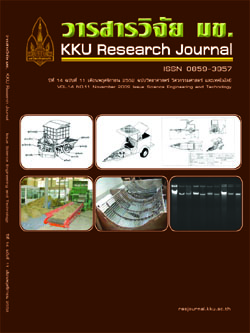Dynamic layout using genetic algorithm in case of unequal area (Thai)
Main Article Content
Abstract
This study investigates the dynamic layout problems in flexible manufacturing systems. The dynamic layout model considers both qualitative and quantitative flow data with different shapes and areas of facilities in open space areas where the distance between two facilities is defined by the rectilinear distance between any two load/unload points located in the center of those facilities. The objective is to minimize the total cost consisting of workflow cost and rearrangement cost by considering the tradeoff between both costs by using the growth methods and the fixed position of identical facilities in two consecutive periods t and t+1 which are embedded in the Genetic Algorithm.
Numerical experiments made clear that the proposed method yields a near optimum layout and provides much better solution than the fixed layout method by up to 5% especially in small problems where the rearrangement costs are small.
Article Details
References
Balakrishnan , J., Cheng, C.H. and Conway, D.G.2002. An improved pair-wise exchangeheuristic for the dynamic plant layoutproblem. International Journal of ProductionResearch. 38(13): 3067-3077.
Balakrishnan , J., Cheng, C.H. and Wong, K.F.2003.FACOPT: A user friendly facilitylayout optimization system. Computer &Operation Research 30(11): 1625-1641.
Buffa, E.S., Armour, G.C. and Vollmann, T.E.1964,Allocating facilities with CRAFT, HardvardBusiness Review, 42(2): 136-159.
Chen, C.W., and Sha,D.Y. 1999. A design approachto the multi-objective facility layout problem.International Journal of ProductionResearch. 37(5): 1175-1196.
Donaghey, C. E., and Pire, V. F., 1990. çSolving theFacility Layout Problem with BLOCPLANéIndustrial Engineering Department,University of Houston, TX.
Goldberg, D. 1989. Genetic Algorithms in search,optimization, and machine learning,Addison-Wesley, Reading, MA.
Hamamoto, S., Yih, Y. and Salvendy, G. 1999.Development and validation of geneticalgorithm-based facility layout.International Journal of ProductionResearch. 37(4): 749-768.
Hassan, M. M. D., Hogg, G. L. and Smith, D. R.1986, SHAPE: A construction algorithmfor area placement evaluation. InternationalJournal of Production Research, 24(5):1283-1295.
Imam, M.H. amd Mir, M. 1998. Cluster boundarysearch algorithm for building-block layoutoptimization. Advance in EngineeringSoftware. 29(2): 165-173.
Islier, A.A. 1998. A genetic algorithm approach formultiple criteria facility layout design.International Journal of ProductionResearch. 36(6): 1549-1569.
Kochhar, J.S., Foster, B.T., and Heragu, S.S. 1998.HOPE: A genetic algorithm for the unequalarea facility layout problem. ComputerOperation Research. 25(7/8): 583-594.
Krishnan, K.K., Cheraghi, S.H., and Nayak, N.C.2006. Dynamic From-Between Chart: a newtool for solving dynamic facility layoutproblems. International Journal Industrialand Systems Engineering. 1(2): 182-200.
Lee, R.C. and Moore, J.M. 1967, CORELAP-Computerized Relationship Layout Planning,Journal of Industrial Engineering, 18(3):195-200.
Mavridou, T.D. and Pardalos, P.M. 1997.Simulatedannealing and genetic algorithms for thefacility layout problem: A survey,Computational Optimization andApplications, 7(1): 111-126.
Murata, T.1997, Genetic algorithms for multi-objectiveoptimization. Degree of Doctor ofEngineering Osaka Prefecture University.Osaka Japan.
Peerapattana, P. 2004. Dynamic Facility Layoutwith Alternative Processing Routes.Degree of Doctor of Engineering OsakaPrefecture University. Osaka Japan.
Sha, D.Y. and Chen, C.W. 2001. A new approach tothe multiple objective facility layoutproblem. Integrated ManufacturingSystems. 12(1): 59-66.
Tompkins, J.A., White, J.A., et al. 1996. Facilitiesplanning. 2nd ed. USA: John Wiley & Sons.
Urban, T.L. 1993, Aheuristic for the dynamic facilitylayout problem, IIE Transactions, 25(4):57-63.
Wang, M.J., Hu, M.H. and Ku, M.Y. 2005.A solution to the unequal area facilitylayout problem by genetic algorithm.Computers in Industry, Vol.56: 207-220.


